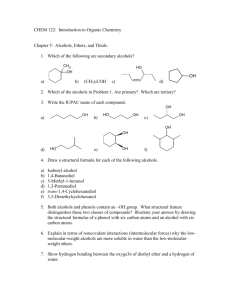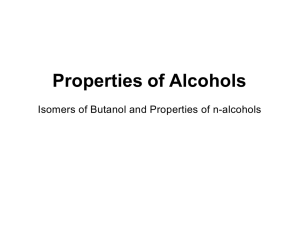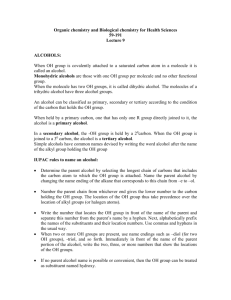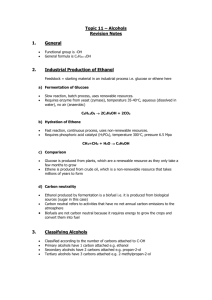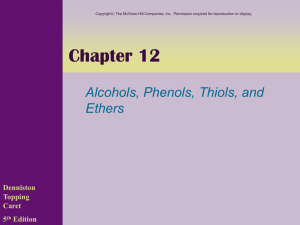Lecture notes chapter 5-6
advertisement
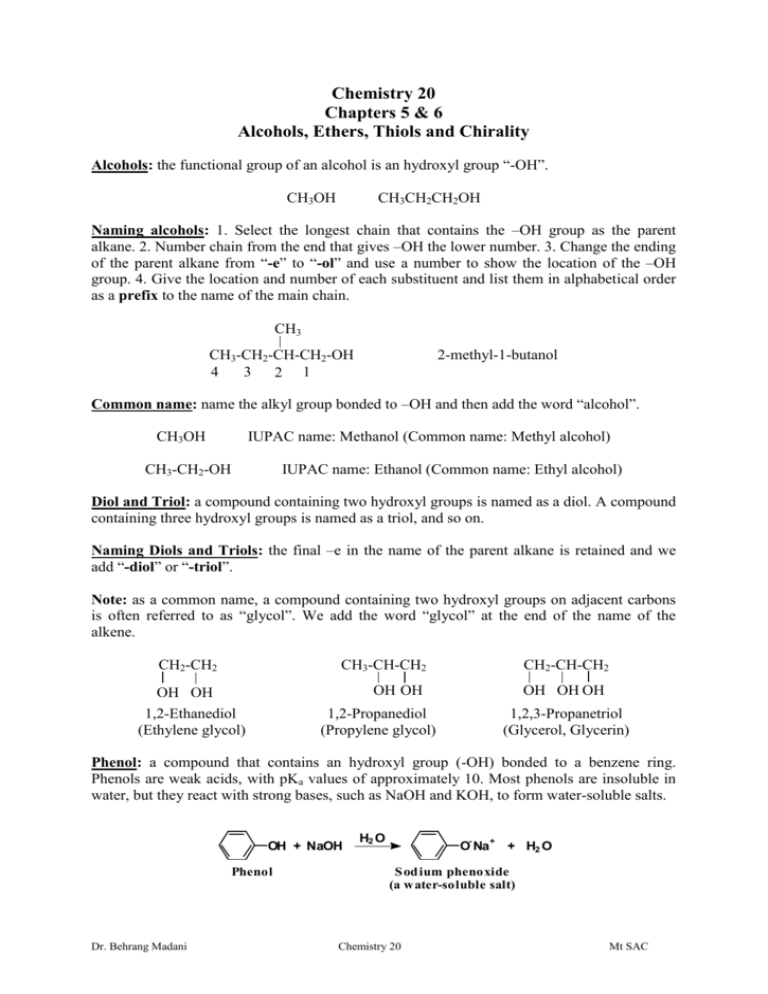
Chemistry 20 Chapters 5 & 6 Alcohols, Ethers, Thiols and Chirality Alcohols: the functional group of an alcohol is an hydroxyl group “-OH”. CH3OH CH3CH2CH2OH Naming alcohols: 1. Select the longest chain that contains the –OH group as the parent alkane. 2. Number chain from the end that gives –OH the lower number. 3. Change the ending of the parent alkane from “-e” to “-ol” and use a number to show the location of the –OH group. 4. Give the location and number of each substituent and list them in alphabetical order as a prefix to the name of the main chain. CH3 CH3-CH2-CH-CH2-OH 4 3 2 1 2-methyl-1-butanol Common name: name the alkyl group bonded to –OH and then add the word “alcohol”. CH3OH IUPAC name: Methanol (Common name: Methyl alcohol) CH3-CH2-OH IUPAC name: Ethanol (Common name: Ethyl alcohol) Diol and Triol: a compound containing two hydroxyl groups is named as a diol. A compound containing three hydroxyl groups is named as a triol, and so on. Naming Diols and Triols: the final –e in the name of the parent alkane is retained and we add “-diol” or “-triol”. Note: as a common name, a compound containing two hydroxyl groups on adjacent carbons is often referred to as “glycol”. We add the word “glycol” at the end of the name of the alkene. CH2-CH2 OH OH 1,2-Ethanediol (Ethylene glycol) CH3-CH-CH2 CH2-CH-CH2 OH OH OH OH OH 1,2-Propanediol (Propylene glycol) 1,2,3-Propanetriol (Glycerol, Glycerin) Phenol: a compound that contains an hydroxyl group (-OH) bonded to a benzene ring. Phenols are weak acids, with pKa values of approximately 10. Most phenols are insoluble in water, but they react with strong bases, such as NaOH and KOH, to form water-soluble salts. OH + NaOH Phenol Dr. Behrang Madani H2 O - O Na + + H2 O S od ium phenoxide (a w ater-soluble salt) Chemistry 20 Mt SAC Classification of alcohols: alcohols are classified as primary (1), secondary (2), or tertiary (3), depending on number of carbon atoms bonded to the carbon bearing the –OH group. CH3 -C-OH H CH3 -C-OH CH3 CH3 -C-OH H A 1° alcohol CH3 A 2° alcohol CH3 A 3° alcoh ol H Physical properties of alcohols: 1. Because of the large difference in electronegativity between oxygen and carbon (3.5 - 2.5 = 1.0) and between oxygen and hydrogen (3.5 - 2.1 = 1.4), alcohols are polar molecules. 2. There is hydrogen bonding between the alcohol molecules (because of –OH). 3. Alcohols have higher boiling points than do alkans, alkenes, and alkynes of similar molecular weight (hydrogen bonding and dipole-dipole interactions are stronger than London dispersion forces). 4. The larger alcohol molecules (higher molecular weight) have higher boiling points. 5. Alcohols are much more soluble in water than are alkanes, alkenes, and alkynes (solubility decreases when molecular weight increases). They are weak acids (weaker than phenol). Chemical properties of alcohols: 1. Acidity of alcohols: Phenols are weak acids and react with aqueous sodium hydroxide to form water-soluble salts. Alcohols are considerably weaker acids than phenols and do not react in this matter. 2. Acid-Catalyzed Dehydration alkenes: we can convert an alcohol to an alkene by eliminating a molecule of water from adjacent carbon atoms in a reaction called dehydration. The dehydration of an alcohol is most often brought about by heating it with either 85% phosphoric acid or concentrated sulphuric acid. CH3 CH2 OH Ethan ol H2 SO4 180°C CH2 =CH2 + H2 O Ethylene Note: Primary alcohols-the most difficult to dehydrate- generally require heating in concentrated sulphuric acid at temperature as high as 180ºC. Secondary alcohols undergo dehydration at somewhat lower temperature. Tertiary alcohols undergo dehydration at temperature only slightly above room temperature. Note: Dehydration is reversible and by adding water to an alkene we can produce an alcohol (hydration). C C + H2 O dehydration de h yd ration An alk ene Dr. Behrang Madani Chemistry 20 C C H OH An alcoh ol Mt SAC 3. Oxidation of alcohols: 3.1. Oxidation of primary alcohols (1): in the oxidation of a primary alcohol (1°), one H is removed from the –OH group and another H from the C bonded to the –OH (oxidation is either the loss of hydrogens or the gain of oxygens). A primary alcohol can be oxidized first to an aldehyde and then to a carboxylic acid. In this reaction, Potassium dichromate (K2Cr2O7) will be used as the oxidizing agent and concentrated sulfuric acid solution is used as a catalyst. O OH CH3-C-H CH3-C-H + H2O H Ethanol (Ethyl alcohol) Ethanal (Acetaldehyde) 3.2. Oxidation of secondary alcohols: it is similar to the oxidation of primary alcohols. Secondary alcohols may be oxidized to ketones by using potassium dichromate as the oxidizing agent. OH O CH3-C-CH3 CH3-C-CH3 + H2O H 2-propanol 2-propanone Note: tertiary alcohols resist oxidation because the carbon bearing the -OH is bonded to three carbon atoms and, therefore, cannot form a carbon-oxygen double bond. Note: in our body, enzymes in the liver oxidize ethanol and the aldehydes can be produced. The blood alcohol over 0.4% can be fatal. Ethers: the functional group of an ether is an atom of oxygen bonded to two carbon atoms (C-O-C). Naming of ethers: ethers are named by listing the alkyl groups bonded to oxygen in alphabetical order and adding the word “ether”. CH3-O-CH3 CH3-CH2-O-CH2-CH3 CH3-CH2-O-CH3 Dimethyl ether Diethyl ether Ethyl methyl ether Physical properties of ethers: 1. They are polar compounds (oxygen bears a partial negative charge and each attached carbon bears a partial positive charge). 2. Only weak dipole-dipole interactions exist between ether molecules (between carbon atom of a molecule and oxygen atom from another molecule). 3. The boiling points of ethers are higher than hydrocarbons of similar molecular weight (lower than alcohols). 4. They are more soluble in water than hydrocarbons of similar molecule weight (because they are polar). Dr. Behrang Madani Chemistry 20 Mt SAC δ+ δ+ δ+ δ- Chemical properties of ethers: ethers resemble hydrocarbons in their resistance to chemical reaction. They do not participate in oxidation and reduction reactions. Because of their general inertness to chemical reactions, ethers are excellent solvents in which to carry out many organic reactions. Thiol: the functional group of a thiol is an –SH (sulfhydryl) group bonded to a tetrahedral carbon atom. CH3-SH methanethiol CH3-CH2-SH Ethanethiol Naming of thiols: we name them by selecting the longest carbon chain that contains the –SH group. We add the word “-thiol” as suffix to the name of the parent alkane. The parent chain is numbered in the direction that gives the –SH group the lower number. CH3 CH3-CH-CH2-CH2-CH2-SH 4 3 1 5 2 4-methyl-1-pentanethiol Physical properties of thiols: 1. They have unpleasant odors. 2. They are nonpolar compounds (because of the small difference in electronegativity between sulfur and hydrogen (2.5 – 2.1 = 0.4)). 3. They have low boiling points (London dispersion forces). 4. They are almost insoluble in water (because they are nonpolar compounds). Chemical properties of thiols: 1. They are weak acids and react with strong bases such as NaOH to form a salt (ther are comparable in strength to phenols). CH3CH2SH + NaOH H2O CH3CH2S-Na+ + H2O 2. Oxidation of thiols: thiols are readily oxidized to disulfide (-S-S-) by molecular oxygen. They must be protected from contact with air during their storage. This reaction is reversible and disulfides can be reduced by several reducing agents. 2CH3CH2SH + O2 oxidation reduction HOCH2CH2S-SCH2CH2OH Chiral: an object that is not superposable on its mirror image. Achiral: an object that lacks chirality; an object that is superposable on its mirror image. Dr. Behrang Madani Chemistry 20 Mt SAC Stereocenter: a tetrahedral carbon atom that has four different groups bonded to it Enantiomers: isomers that are nonsuperposable mirror images. The most common cause of enantiomerism in organic molecules is the presence of a carbon with four different groups bonded to it (stereocenter). Isomers same different connectivity connectivity Stereoisomers without stereocenters Constitutional Isomers with stereocenters Chiral Achiral Enantiomers Cis-Trans Isomers Diastereomers Note: enantiomers have different physical and chemical properties. Example: 2-butanol is a chiral compound and it is not superposable on its mirror. If we hold the mirror image by the C-OH bond and rotate the bottom part of molecule by 180° about this bond, you can see the orientation of H and -CH2CH3 is different between original molecule and the mirror image rotated. You notice that we have two different compounds. OH 180° C H CH2 CH3 Original molecule H3 C OH H C CH 3 CH3 CH2 Mirror image rotate by 180° about the C-OH b on d OH C CH CH 2 3 H The mirror image rotated b y 180° H3 C Example: 2-propanol is an achiral compound and it is superposable on its mirror. If we hold the mirror image by the C-OH bond and rotate the bottom part of molecule by 120° about this bond, you can see that the original molecule is similar to the mirror image rotated. Consequently, they are identical compounds. OH C H CH3 Origin al molecu le H3 C Dr. Behrang Madani 120° OH H C CH 3 H3 C Mirror image rotate by 120° about th e C-OH bond Chemistry 20 OH H3 C C H CH3 The mirror image rotated b y 120° Mt SAC
